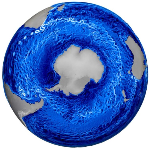
Stopping Unstoppable Sea Level Rise by Manaugh&Majdi
 Thomas Manaugh Jun 5, 2015 11:01 | Proposal contributor
As authors of this proposal, we take full responsibility for its content. However, we acknowledge the valuable feedback we received during its final preparation from Ann Drumm, J.D., Georges Jamieson, PhD, and Sara Manaugh, J.D., PhD. Thank you.
|
 Monika Dos Santos Jun 9, 2015 01:13 |
Thank you for submitting to the adaptation contest. This is a well presented, articulated and novel project.
best wishes
Monika
|
 Michael Hayes Jun 26, 2015 04:17 |
Also, simply desalinating saltwater that is directly under the ice sheets would do the same and be more economical.
As saltwater's freezing point is below freshwater's', the desalinated water will automatically freeze up due to ambient (saltwater) temperature.
This proposal is calling for drilling into glaciers for the freshwater supply. There may be a few technical challenges with that approach. Primarily, keeping the water in the system from freezing up until it is frozen up, on demand, at the intended site.
Michael
|
 Michael Hayes Jun 26, 2015 04:46 |
However, even with the technical challenges, this type of mitigation technology needs to be supported.
Michael
|
 Thomas Manaugh Jun 26, 2015 11:31 | Proposal contributor
Thank you Micheal for your comment. I'm sorry if we were not sufficiently clear about the nature of the water that is to be cooled and directed to a strategic space (channel) under the glacier to form an impediment to the attack on the underside of the glacier from warm seawater. The water to be pumped is not fresh water but, rather, cooled seawater.
Your notion of forming ice from cooling freshwater is an intriguing one, but we are very sure desalination is not very economical in its requirements for sophisticated equipment or its use of energy. We have been looking closely at desalination costs in preparing of other proposals:
https://www.climatecolab.org/web/guest/plans/-/plans/contestId/1300208/phaseId/1300636/planId/1309211
and
https://www.climatecolab.org:18081/web/guest/plans/-/plans/contestId/1301501/planId/1319613
Pumping is probably at least an order of magnitude less expensive than desalination.
Interestingly, fresh water is easily acquired by simply melting glacial ice, which originally came from fallen snow.
Given an abundance of seawater, there does not appear to be much reason to use energy to melt glacial ice to get fresh water except for purposes of drinking. Injecting fresh water under a glacier would be unnecessarily difficult and expensive. Readily cooled seawater should do the trick, and strong winds should provide enough energy for drilling and pumping.
Best regards,
Thomas Manaugh
|
 Thomas Manaugh Jul 12, 2015 07:16 | Proposal contributor
We were able, via email, to contact Dr. Roger Hooke, an expert glaciologist. Our exchange of emails with him was copied and is pasted below. We greatly appreciate his very graciously taking time to review our proposal in detail.
Dr. Hooke is a Retired Research Professor at the Climate Change Institute and the Department of Earth Sciences at the University of Maine, Orono. Most of his work has been in the field of glacial geology and glaciology conducting research in the Canadian Arctic and Northern Sweden. He has authored several papers and books, including "Principles of Glacier Mechanics." Here is a link to read more about Dr. Hooke: http://climatechange.umaine.edu/people/profile/roger_leb_hooke.
---------------------------------------------------------------------------------
Our initial attempt to contact Dr. Hooke (7-4-2015):
>> Dr. Roger LeB. Hooke
>> Climate Change Institute
>> & School of
Earth and Climate Sciences
>> Orono, Maine
>>
>> Dear Dr. Hooke:
>>
>> A
committee of judges at MIT has asked me to find a glaciology expert
>> who
might be willing to comment on a proposal that has been submitted
>> to an MIT
international contest for project proposals dealing with
>> climate
change.
>>
>> It seems the proposal I co-authored regarding the Pine Island
Glacier
>> in West Antarctica presents some complex dynamics, involving
>>
temperature distribution at the glacier-seawater interface. The
>> glacier is
vulnerable to rapid melting from warm seawater penetrating
>> through a narrow
channel to its underside.
>>
>> See
>>
https://www.climatecolab.org/web/guest/plans/-/plans/contestId/1301411/phaseId/1306751/planId/1319603
>>
>>
and judges' request at
>>
https://www.climatecolab.org/web/guest/plans/-/plans/contestId/1301411/phaseId/1309134/planId/1319603/tab/EVALUATION
>>
>>
Would you be willing to talk to me for a few minutes if I were to call
>> you
to get your comment? There are few people in the world who have
>> your kind
of expertise in regard to glacier dynamics, so please
>> consider granting this
small request.
>>
>> Thank you.
>>
>> Thomas Manaugh, PhD
---------------------------------------------------------------
Dr Hooke’s Response to our Request (7-5-2015)
> Tom:-
>
> There are glaciologists with far more
experience with Antarctic
> glaciers than I, and they would be more
appropriate consultants.
>
> Among my concerns are:
>
> 1. The flow of Pine
Island glacier is up to 4 km/yr, which would
> make maintaining an open
borehole somewhat problematic, and would
> require redrilling every few years
to keep the flow of cooled water
> in the place where it would do most
good.
>
> 2. I'd like to see some calculations (at least back-of-the-envelope
> type) to show how much water would have to be pumped to achieve the
>
effect you desire. The water volume would presumably have to be
> comparable
to the volume of ocean flow in under the Pine Island ice
> shelf. You are
trying to counter an inflow of nearly 400,000 m3/s
> (Jacobs et al., 2011,
attached)!
>
> I also note that you misstate the meaning of the red color in
your
> image of Pine Island Glacier. It is the zone of fast flow, not the
> extent of subglacial melting.
>
> Roger
--------------------------------------------------------------
Our Response to Dr. Hooke (7-5-2015)
Roger,
Thank you so much for taking time to look at our proposal and to
send
us a very relevant reference article. You are too modest in your not
rating yourself as a top glaciologist. You are definitely tops from
our
point of view. I will acknowledge your helpfulness to MIT's
judging committee
and post our correspondence in the comments section
for our entry (after
removing any email or phone number information).
Please let me know if that
is not OK with you.
Yes, the bore holes will probably need to be re-bored
numerous times
over the course of years. That is a requirement that will
raise the
cost of the project, but that extra cost will be very small in
comparison with costs associated with not taking actions to mitigate
sea
level rise. Over time, we might find clever ways to make bore
holes faster
and easier to maintain. If the glacier stops slipping so
fast toward the
sea, the bore holes will probably not need to be
re-drilled so often.
We
will correct our mis-characterization of the red area shown in the
graphic
that maps water flow under the Pine Island Glacier. Good catch.
The article
by Jacobs et al helps us to understand better how huge
volumes of warm
seawater are melting the glacier so quickly. We are
especially interested in
the warm seawater that reaches the grounding
line of the glacier because it
causes a more-rapid-than-usual slipping
of the glacier toward and into the
sea.
Our back-of-the-envelope estimate of the volume of warm seawater
causing that rapid slipping puts it at about one percent of the flow
of
warm seawater estimated by Jacobs et al to be flowing under the
glacier's
shelf ice. Still, that one percent represents a huge volume
of water that
needs to be impeded in its flow toward the critical
grounding line
area.
In round numbers, we estimate a measurable decrease in slipping rate
could be achieved by injecting about 1.4 x 10^6 m^3 per day of cooled
seawater into the channel. That volume of flow could be achieved by
pumping seawater downward into injection wells at a velocity of 5
m/sec
through pipes with combined cross-sectional areas equal to a
single pipe with
a diameter of 2 meters. In the channel, the colder
and denser seawater would
tend to build up day-by-day into a kind of
"clot" that will impede the
penetration of warm seawater.
Though the clot would not constitute a
permanent impediment, it would
have a persisting effect on the density and
temperature of the water
in the part of the channel into which it would be
continually
injected. Over the course of a year, the volume of injected
water
would be (365x24x60x60 sec) x (5 m/sec) (pi x (1 m^2)) = 5.0 x 10^8
m^3. That is enough cooled seawater to fill a channel 25000 meters
wide,
10 meters deep, and 2000 meters long. If that had too little
effect, a
larger flow of cooled seawater could be invoked via more
pumping of cooled
seawater down into more injection wells.
We feel we can use existing
technologies (e.g., sensitive detection of
scraping sounds transmitted up
through the glacier) to help locate
drilling spots that are very near the
glacier's grounding line.
Modeling and simulation will be used to specify
exact locations to
continually inject adequate amounts of cooled seawater.
That will be
critical to the goal of creating a persisting effect on the
temperature and density of the water in the channel at and near the
grounding line.
Sincerely,
Tom
|
 Tanya D Sep 8, 2015 05:41 | We need to take the threat of rising sea water seriously while there is time to act! Funding for this proposal would allow evaluation of feasibility and ensure no unanticipated negative effects on local ecosystem. Much easier to research and implement a solution like this, than to change the (bad) habits of billions of people within a couple of years.. |
 Daniel Rosensweig Oct 2, 2015 05:12 | Solarsupporter, that would be easier, but it wouldn't solve the problem. |